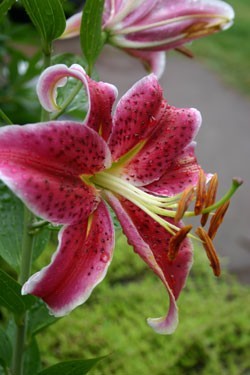
Fall is not the time for cold climate flower gardeners to "live in the moment." It is actually the time when planning for next spring's blooms will produce the biggest payoffs. Here is a handy guide on how to plan and plant bulbs for the first blooms of next year's season.
Compile a list of suitable choices by finding out what types of bulbs grow best in your climate. All bulbs need cold weather to develop, but some are more susceptible to death or damage from freezing. Look for the biggest bulbs and make sure they are free from pits and mold. The longevity of your plantings will depend on the type of bulbs you select. Some, like tulips, are usually only bred to last from 1-3 years. Others, like galantus, will last for years. Chose bulbs carefully (early, mid and late spring bloomers) and you can enjoy flowers from bulbs long into next year's growing season.
Be careful when ordering bulbs from catalogs or from growers whose stock in not grown in your climate. Good growers will list the hardiness zones for each variety. If it isn't listed as hardy for your area, don't buy it.
The type and size of the bulbs you are planting will determine the depth of planting. As a rule, larger bulbs need to be planted deeper than smaller bulbs. Measure the diameter of the bulb and then multiply that number by three to find the proper planting depth. Tulips are generally planted to a depth of 7-8 inches. All bulbs should be planted with their flat end (basil plate) down so their roots can grow into the soil and their tops up, since that is where the bloom will emerge.
After digging a hole to the proper depth, loosen the soil below where the bulbs will be placed. Add a bit of organic fertilizer, top it off with a bit of dirt, place the bulbs in the hole and then fill in the hole with dirt.
Bulbs need lots of water when they are first planted so they can put their energy into developing roots. They don't need much water after that, so make sure to plant them in well-drained soil.
After blooming, it takes a long time for foliage to die back. Planting bulbs along the back of your perennial beds will help later emerging plants hide unsightly foliage as it is dying.
Bulbs planted in rows end up looking straggly because invariably one or more in a row will fail to come up. Spring bulbs will do much better and look much better if they are planted in clumps. Think circles, triangles, or oval shaped plantings for masses of color.
Planting bulbs in both sunny and shady areas of the garden will extend your blooming season. Sunny bulbs will emerge and bloom first.
Keep bulbs from freezing and thawing over winter by mulching them with a few in inches of clean straw or raking fall leaves onto bulb beds. Include the depth of your mulch to the overall depth of your planting. You can remove the mulch in spring or let it continue decomposing into the soil.
One of squirrels favorite fall activities is digging up next spring's bulbs. Tacking down a bit of screen or sprinkling blood meal over beds will help deter most hungry wildlife. If you have a history of losing bulbs to foraging animals, try going heavy on daffodils. They don't need protection because their bulbs are poisonous. Animals know it and avoid them.
Daffodils, lilies (Asiatic, Oriental, Martagon and Trumpet varieties), hyacinths, crocuses, alliums, tulips (hundreds of varieties available), galantus, snow drops, anemone, ornamental onions, and blue squall.

About The Author: Ellen Brown is our Green Living and Gardening Expert. Ellen is an environmental writer and photographer and the owner of Sustainable Media, an environmental media company that specializes in helping businesses and organizations promote eco-friendly products and services.
Add your voice! Click below to comment. ThriftyFun is powered by your wisdom!
Add your voice! Click below to comment. ThriftyFun is powered by your wisdom!